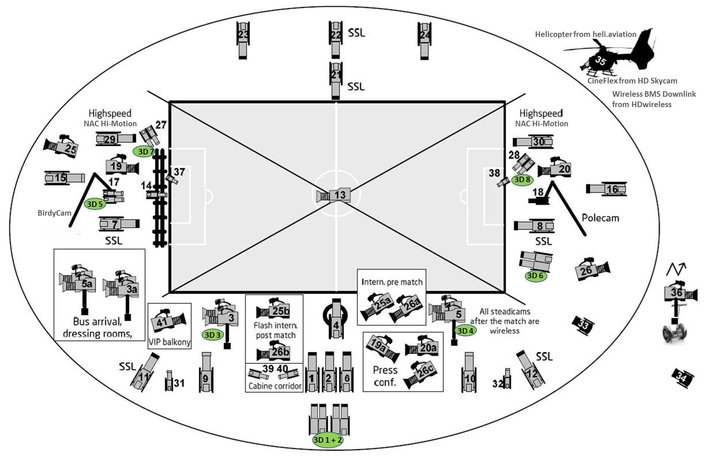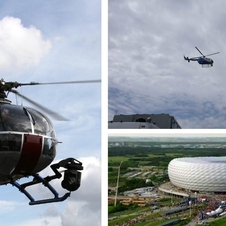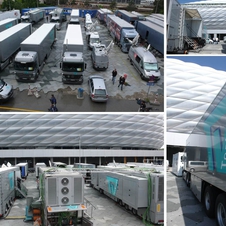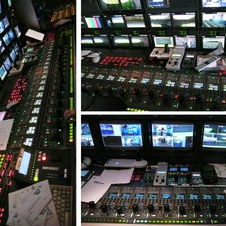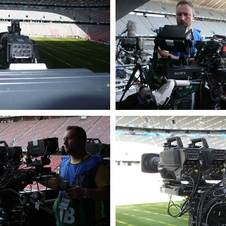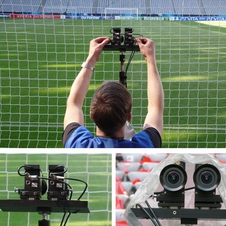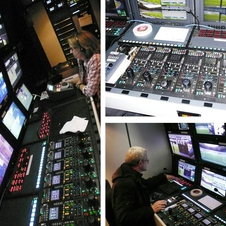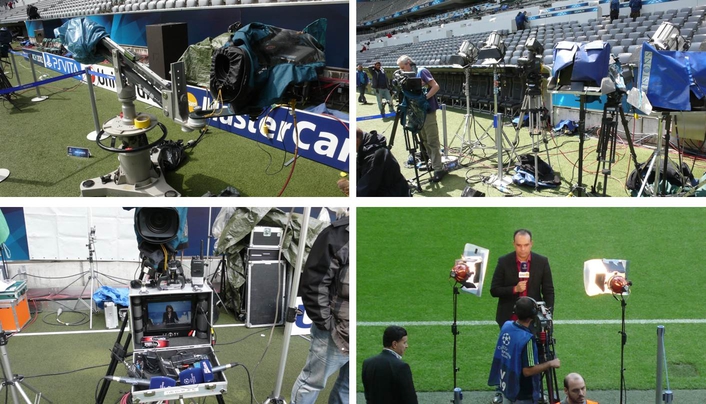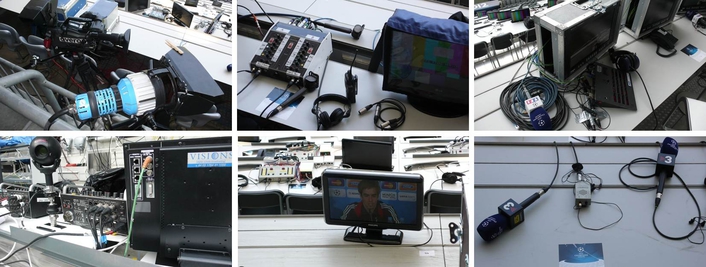UEFA Champions League Final 2012: World Feed in HD and 3D
posted:
Bayern set up camp in the Chelsea half for the majority of the match, but were extremely wasteful in front of goal, passing up a number of opportunities that allowed Roberto Di Matteo's men to stay in the contest. Thomas Muller looked to have finally broken their resistance when he scored in the 83rd minute, but Didier Drogba brought the Blues back from the dead with a powerful header two minutes from the end to send the final into extra time. A missed Arjen Robben penalty in extra time sent the final to penalties, where Didier Drogba struck the winning attempt from the spot to send the Londoners to their first ever Champions League crown.
Sky Deutschland won the bid to serve as host broadcaster last year with preparations beginning in October. In February those preparations became a 24/7 operation, as the team began working with the UEFA, the Allianz Arena, international rights holders and German OB production company TopVision. TopVision provided 90 skilled people and its HD OBVans HD Ü1 (for the 3D production), HD Ü2 (world feed B & C) and HD Ü4 (Sky Deutschland unilateral) together with four tender trucks. But in a first for a Champions League event, the main production gallery (world feed A) was produced in a spacy container cabin to give the director visibility of the live signals from more than 40 cameras in the arena plus the various replay signals.
advertisment
In addition to the 25 cameras we see at the Champions League quarter- and half-finals we saw two NAC Hi-Motion cameras, six SuperSloMo cameras, two GoalCams (TV-Skyline), a Spidercam, a Q-Ball rail camera, a BirdyCam, a Polecam, a wireless camera on a Segway, an additional beauty shot on a crane and a helicopter with Cineflex at the Champions League Final in Munich. All the camera signals were recorded on eighteen EVS XT[2] and XT[3] servers for having the option of building replays from all the camera feeds.
advertisment
Also five left eye signals from the eight 3D cameras were integrated into the HD production while four HD camera feeds could be converted into 3D and were used to enhance the 3D production. The 3D world feed was distributed to eleven right holding broadcasters.
However there were many more cameras on-site: Twenty international Broadcasters were on location having brought in unilateral cameras for their pregame, halftime and postgame analysis.
The HD Production
The HD Production of the three world feeds in 1080i/50 (A, B & C) was carried out in TopVision's HD Ü2, HD Ü4 and an additional production gallery located in a spacious container. The shading and monitoring of the 40 camera signals were distributed 50/50 between Ü2 and Ü4. This distribution of the camera feeds between the two HD OBVans also guaranteed the backup scenario in the unlikely event of a failure in one of the OBVans.
advertisment
The cameras in the arena consisted of Sony HDC-1500's and HDC-1000's all with Canon lenses. The wireless camera on the Segway, as well as the camera in the CineFlex (from HD Skycam) on the helicopter (from heli.aviation), were Sony HDC-1500's. These wireless installations were supported by HDwireless. The BirdyCam (17), the Polecam (18) the behind the Goal-Cams (27 + 28) and the beauty shot cameras (33 + 34) were HD1200's from LMP. The six SuperSloMo cameras (7, 8, 11, 12, 21 + 22) were HDC-3300's from Sony while the two UltraMotion cameras (29 + 30) were NAC Hi-Motion's. Finally the Spidercam (13) was equipped with a Panasonic AK-HC1500 and the Railcam behind the goal (14) was equipped with a Q-Ball from Camera Corps. Both cameras were operated by PMT.
advertisment
advertisment
On world feed B & C the pre-match interviews started at 17:00h and were directed by Georg Albers working on a Sony MVS-8000 in the production area of Tender 2. Georg Albers was also responsible for the signal covering the players arriving from their cabins onto the playground, for the super flash summery after the match and the post-match interviews.
advertisment
The Ambience signal for world feed A from 18:00h - 20:15h was produced in the video gallery of Ü2 (with Sony MVS-8000) by Manuel Kock. From 20:15h to the end of the match the program signals (Worldfeed A, B & C) were produced in the video gallery in the container (again with a Sony MVS-8000) by director Knut Fleischmann and slomo director Ralf Armbrüster. Audio was mixed on Stagetec Aurus consoles.
All the graphics were produced in five languages (English, French, Italian, Spanish and German) in a graphics van supplied by Deltatre.
advertisment
The world feed A, B & C signals arrived at the Technical Operation Center (TOC) and were distributed to the 238 rights-holding broadcasters in HD (or SD if requested). Also 20 isolated camera feeds were available here for the 20 international broadcasters on site. Centerpiece for all the distribution was a Grass Valley Trinix routing switcher.
advertisment
The 3D Production
The 3D production was carried out in TopVision's dedicated 3D OBVan Ü1. The director Marcus Olschewski had the choice of eight native 3D signals and of four HD to 3D converted signals (Spidercam, both 16m high plus one more which could be selected via a routing matrix) for the built-up of the 3D world feed. Olschewski was working on a Sony MVS-7000 where he also was able to include the replay feeds offered by three dedicated 3D slomo operators. The 3D convergence engineers were supervised by Richard Hingley.
The 3D cameras consisted of HDC-1500 pairs for camera positions 1 + 2 (on 3ality Technica side-by-side rigs) and for camera position 6 (on a 3ality Technica mirror rig). The camera positions 3 + 4 were PMW-TD300 on Steadicams. Cameras on position 5, 7 + 8 were HD1200 from LMP, all on LMP side-by-side rigs.
Audio was mixed on a Stagetec Aurus console and the 3D graphics were produced in a dedicated 3D graphics van from Deltatre
The Sky Deutschland Unilateral Production
After Bayern München defeated Real Madrid and qualified for the Champions League Final, Sky Deutschland realized it would need to increase the domestic production efforts and increased their unilateral cameras to twelve. The domestic show started at 18:00h and stayed on for more than six hours. According to Alessandro Raitano, Director Production Sport at Sky Deutschland, Sky has changed the pre-game, half-time and post-game analysis to be a more American style show with a roundtable of five experts, including a former referee. This is something Fox Sports in the U.S. has done for its American football coverage, with the referee giving insights into how the referees on the field approach critical decisions.
A growing dialogue between Sky Deutschland and their U.S. counterparts at Fox Sports in Los Angeles, a broadcaster well versed in having a large number of anaysts and experts on air for a big event, helped Sky Deutschland to become comfortable with the approach. Already since the last Bundesliga season Sky changed the style to be more American with a pitch-side table with analyst. Also the graphical presentation was enhanced with more graphics and sound effects. The Sky subscribers have reacted positively to these changes and Sky has achieved a positive differentiation compared to other German broadcasters (like Sat.1).
The domestic coverage of the Champions League Final relayed still heavily on Knut Fleischmann directing the international feed. However Thomas Sohns (the director of the unilateral Sky Deutschland feed, which was produced in TopVision's Ü4) took the international feed and cut in shots from the unilateral cameras to help give a bit more of the home-team perspective for German viewers.
UEFA's Global Digital Success
UEFA had enlarged the media tribune with 119 TV commentary positions and 300 media seats with desk. Also eight pitch view studios and three indoor studios were prepared for the rights-holding broadcasters. In addition 16 flash positions at play ground level were offered and the mixed zone was enlarged.
In addition to the international TV signals the 2012 UEFA Champions League final was delivered to millions of fans worldwide across various platforms. UEFA's digital strategy ensured the UEFA Champions League final reached fans on platforms including UEFA.com, Google+, Facebook, Twitter, YouTube and Foursquare.
The 19 May showpiece between FC Bayern München and Chelsea FC had a global live reach of over 300 million people watching on television, with supporters also able to receive digital content throughout the week leading up to the game and during the final itself.
UEFA communications director Alexandre Fourtoy said: "The success of the various social media platforms covering the UEFA Champions League final and related activities shows fans are at the core of UEFA's approach. UEFA is proud to develop this direct bond with fans through its digital communications strategy, as fans make European football what it is."
• A 12% increase on UEFA.com compared to the same period last year.
• 4.8 million tweets with reference to the final, the teams and the players. The real-time monitoring reflected the exciting climax of the game, with more than 100,000 tweets sent in the minute after Didier Drogba's equalizer.
• 52,000 new Facebook likes, bringing the total of fans on the UEFA Champions League page to nearly 2.5 million.
• Over 20,000 UEFA Champions League Foursquare badges featuring the UEFA Champions League trophy were unlocked on the day of the final. UEFA's ground-breaking global Foursquare campaign enabled fans to check in anywhere they were watching the final by using the phrase 'UEFA Champions League' as a shout.
As with every UEFA Champions League final, the Munich arena boasted the unique look and feel in line with the UEFA branding.
Credits
Sky Deutschland
Alessandro Raitano, Director Production Sport
Stephan Gollnick, Head of International Football
Aegidius Mair, Champions League Final Production Coordinator
Directors
Knut Fleischmann, Director World Feed
Manuel Knock, Director Ambience Feed
Marcus Olschewski, Director 3D Feed
Georg Albers, Director Multilateral Feed
Thomas Sohns, Director Unilateral Feed
TopVision
Achim Jendges, Technical Director
Eduard Palasan, Head of Production
Kerstin Fluhrer, Production Supervisor



